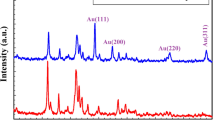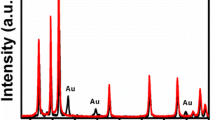Abstract
In this study, pulsed laser ablation was utilized to produce gold nanoparticles (Au NPs), hydroxyapatite NPs, and then conjugated with cefuroxime as a heteronanocomposite structure targeting Klebsiella pneumoniae. When Klebsiella forms a biofilm, it shows a remarkable resistance against a variety of antibiotics. The heterostructure nanocomposite was characterized using UV/Vis spectrophotometry, X-ray diffraction (XRD), Fourier transform infrared spectroscopy (FTIR), and transmission electron microscopy (TEM). The antibacterial activity of the heteronanocomposite against Klebsiella pneumoniae was assessed and compared with the cefuroxime alone. The inhibitory action of the heteronanocomposite of biofilm in the urinary catheter (Foley’s catheter) was examined by atomic force microscopy (AFM). The results of the current study demonstrated that the heteronanocomposite had antimicrobial activity greater than cefuroxime alone to stop the growth of microbial biofilms. This heteronanocomposite has shown a promising result, which could be a reliable therapy against Klebsiella pneumoniae in the future and could be a promising agent for succeeding bacterial biofilm inhibition during a urinary tract infection.











Similar content being viewed by others
Data Availability
Not applicable.
References
Hussain I, Singh NB, Singh A, Singh H, Singh SC (2016) Green synthesis of nanoparticles and its potential application. Biotech Lett 38:545–560
Sharma R, Prajapati PK (2016) Nanotechnology in medicine: leads from Ayurveda. J Pharm Bioallied Sci 8(1):80–81
Mustapha T, Misni N, Ithnin NR, Daskum AM, Unyah NZ (2022) A review on plants and microorganisms mediated synthesis of silver nanoparticles, role of plants metabolites and applications. Int J Environ Res Public Health 19(2):674
Roduner E (2006) Size matters: why nanomaterials are different. Chem Soc Rev 35(7):583–592
Yue HL, Hu YJ, Chen J, Bai AM, Ouyang Y (2014) Green synthesis and physical characterization of Au nanoparticles and their interaction with bovine serum albumin. Colloids Surf B 122:107–114
Padmavathy N, Vijayaraghavan R (2008) Enhanced bioactivity of ZnO nanoparticles—an antimicrobial study. Sci Technol Adv Mater
López-Esparza J, Espinosa-Cristóbal LF, Donohue-Cornejo A, Reyes-López SY (2016) Antimicrobial activity of silver nanoparticles in polycaprolactone nanofibers against gram-positive and gram-negative bacteria. Ind Eng Chem Res 55(49):12532–12538
Munoz-Escobar A, Ruíz-Baltazar ÁDJ, Reyes-López SY (2019) Novel route of synthesis of PCL-CuONPs composites with antimicrobial properties. Dose-Response 17(3):1559325819869502
Yuan Q, Xu A, Zhang Z, Chen Z, Wan L, Shi X, Deng L (2018) Bioactive silver doped hydroxyapatite composite coatings on metal substrates: synthesis and characterization. Mater Chem Phys 218:130–139
Tian B, Chen W, Dong Y, Marymont JV, Lei Y, Ke Q, Zhu Z (2016) Silver nanoparticle-loaded hydroxyapatite coating: structure, antibacterial properties, and capacity for osteogenic induction in vitro. RSC Adv 6(11):8549–8562
Zhang XF, Liu ZG, Shen W, Gurunathan S (2016) Silver nanoparticles: synthesis, characterization, properties, applications, and therapeutic approaches. Int J Mol Sci 17(9):1534
Khan AK, Rashid R, Murtaza G, Zahra AJTR (2014) Gold nanoparticles: synthesis and applications in drug delivery. Trop J Pharm Res 13(7):1169–1177
Cephalosporins (2022) Available online: https://www.ncbi.nlm.nih.gov/books/NBK551517
Nicolle LE (2005) Catheter-related urinary tract infection. Drugs Aging 22:627–639
Govindasamy GA, Mydin RBS, Sreekantan S, Harun NH (2021) Effect of calcination temperature on physicochemical and antimicrobial properties of green synthesised ZnO/C/Ca nanocomposites using Calotropis gigantea leaves. Adv Nat Sci Nanosci Nanotechnol 12(1):015013
Govindasamy GA, Mydin RBS, Sreekantan S, Harun NH (2021) Compositions and antimicrobial properties of binary ZnO–CuO nanocomposites encapsulated calcium and carbon from Calotropis gigantea targeted for skin pathogens. Sci Rep 11(1):99
Govindasamy GA, SMN Mydin RB, Gadaime NK, Sreekantan S (2023) Phytochemicals, biodegradation, cytocompatibility and wound healing profiles of chitosan film embedded green synthesized antibacterial ZnO/CuO nanocomposite. J Polym Environ 1–17
Yu J, Nan J, Zeng H (2017) Size control of nanoparticles by multiple-pulse laser ablation. Appl Surf Sci 402:330–335
Doñate-Buendía C, Fernández-Alonso M, Lancis J, Mínguez-Vega G (2020) Pulsed laser ablation in liquids for the production of gold nanoparticles and carbon quantum dots: from plasmonic to fluorescence and cell labelling. In: Journal of Physics: Conference Series (Vol 1537, No 1, p 012013). IOP Publishing
Zhang WH, Shi JL, Wang LZ, Yan DS (2000) Preparation and characterization of ZnO clusters inside mesoporous silica. Chem Mater 12(5):1408–1413
Manikandan C, Amsath A (2019) Antibiotic susceptibility of bacterial strains isolated from patients with respiratory tract infections. Int J Pure Appl Zool 1(1):61–69
Kadhim WKA, Nayef UM, Jabir MS (2019) Polyethylene glycol-functionalized magnetic (Fe3O4) nanoparticles: a good method for a successful antibacterial therapeutic agent via damage DNA molecule. Surf Rev Lett 26(10):1950079
Khashan KS, Jabir MS, Abdulameer FA (2018) Preparation and characterization of copper oxide nanoparticles decorated carbon nanoparticles using laser ablation in liquid. In: Journal of Physics: Conference Series (vol 1003, p 012100). IOP Publishing
Al Rugaie O, Jabir MS, Mohammed MK, Abbas RH, Ahmed DS, Sulaiman GM, Mohammed HA (2022) Modification of SWCNTs with hybrid materials ZnO–Ag and ZnO–Au for enhancing bactericidal activity of phagocytic cells against Escherichia coli through NOX2 pathway. Sci Rep 12(1):17203
Jawad KH, Marzoog TR, Hasoon BA, Sulaiman GM, Jabir MS, Ahmed EM, Khalil KA (2022) Antibacterial activity of bismuth oxide nanoparticles compared to amikacin against acinetobacter baumannii and staphylococcus aureus. J Nanomater
Ali IH, Jabir MS, Al-Shmgani HS, Sulaiman GM, Sadoon AH (2018) Pathological and immunological study on infection with Escherichia coli in ale balb/c mice. In: Journal of Physics: Conference Series (vol 1003, p 012009). IOP Publishing
Younus A, Al-Ahmer S, Jabir M (2019) Evaluation of some immunological markers in children with bacterial meningitis caused by Streptococcus pneumoniae. Res J Biotechnol 14:131–133
Munita JM, Arias CA (2016) Mechanisms of antibiotic resistance. Virulence mechanisms of bacterial pathogens, 481–511
Nirwati H, Sinanjung K, Fahrunissa F, Wijaya F, Napitupulu S, Hati VP, Nuryastuti T (2019) Biofilm formation and antibiotic resistance of Klebsiella pneumoniae isolated from clinical samples in a tertiary care hospital, Klaten, Indonesia. In: BMC proceedings (vol 13, No 11, pp 1–8). BioMed Central
Kapoor G, Saigal S, Elongavan A (2017) Action and resistance mechanisms of antibiotics: a guide for clinicians. J Anaesthesiol Clin Pharmacol 33(3):300
Reygaert WC (2018) An overview of the antimicrobial resistance mechanisms of bacteria. AIMS Microbiol 4:482–501
Mala R, Arunachalam P, Sivasankari M (2012) Synergistic bactericidal activity of silver nanoparticles and ciprofloxacin against phytopathogens. J Cell Tissue Res 12(2):3249
Nikparast Y, Saliani M (2018) Synergistic effect between phyto-syntesized silver nanoparticles and ciprofloxacin antibiotic on some pathogenic bacterial strains. J Med Bacteriol 7(1–2):36–43
Zhou XH, Wei DX, Ye HM, Zhang X, Meng X, Zhou Q (2016) Development of poly (vinyl alcohol) porous scaffold with high strength and well ciprofloxacin release efficiency. Mater Sci Eng C 67:326–335
Ahire JJ, Neveling DP, Hattingh M, Dicks LM (2015) Ciprofloxacin-eluting nanofibers inhibits biofilm formation by Pseudomonas aeruginosa and a methicillin-resistant Staphylococcus aureus. PLoS ONE 10(4):e0123648
Huang D, Ou B, Prior RL (2005) The chemistry behind antioxidant capacity assays. J Agric Food Chem 53(6):1841–1856
Daniels SL, Pressman JG, Wahman DG (2016) AFM structural characterization of drinking water biofilm under physiological conditions. RSC Adv 6(7):5812–5816
Kwon TH, Kim S (2017) Measuring elastic modulus of bacterial biofilms in a liquid phase using atomic force microscopy. Geomechanics Eng 12:863–870
Dufrêne YF (2002) Atomic force microscopy, a powerful tool in microbiology. J Bacteriol 184(19):5205–5213
Acknowledgements
The authors appreciated the University of Technology, Iraq, for the logistic support of this work.
Author information
Authors and Affiliations
Contributions
Hadeel M. Yosif and Majid S. Jabir: writing original draft, methodology, investigation and formal analysis. Buthenia A. Hasoon and Majid S. Jabir: main concept, data interpretation, and supervision. Majid S. Jabir and Buthenia A. Hasoon: writing—review and editing, visualization, and data curation. All authors reviewed the manuscript.
Corresponding author
Ethics declarations
Conflict of Interest
The authors declare no competing interests.
Additional information
Publisher's Note
Springer Nature remains neutral with regard to jurisdictional claims in published maps and institutional affiliations.
Rights and permissions
Springer Nature or its licensor (e.g. a society or other partner) holds exclusive rights to this article under a publishing agreement with the author(s) or other rightsholder(s); author self-archiving of the accepted manuscript version of this article is solely governed by the terms of such publishing agreement and applicable law.
About this article
Cite this article
Yosif, H.M., Hasoon, B.A. & Jabir, M.S. Laser Ablation for Synthesis of Hydroxyapatite and Au NP Conjugated Cefuroxime: Evaluation of Their Effects on the Biofilm Formation of Multidrug Resistance Klebsiella pneumoniae. Plasmonics 19, 1085–1099 (2024). https://doi.org/10.1007/s11468-023-02053-y
Received:
Accepted:
Published:
Issue Date:
DOI: https://doi.org/10.1007/s11468-023-02053-y




